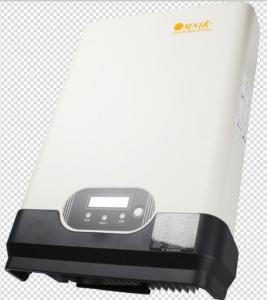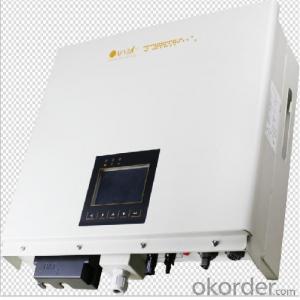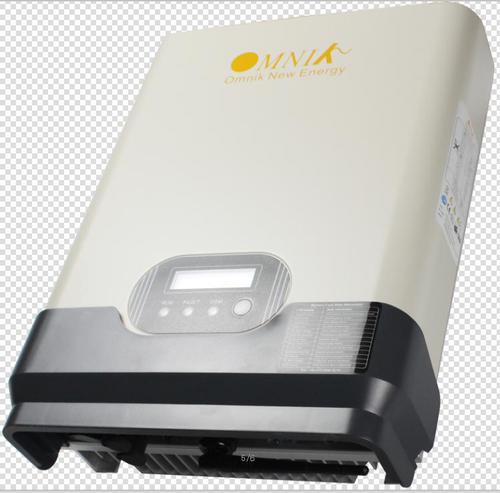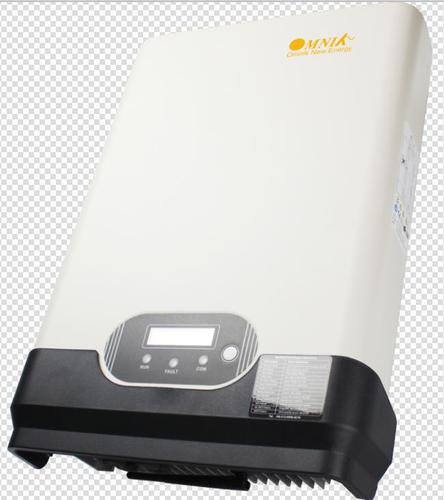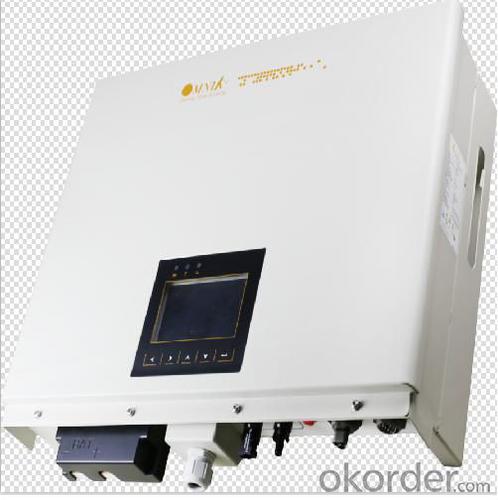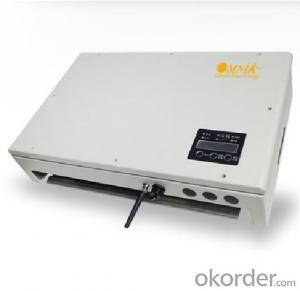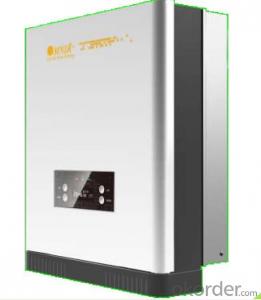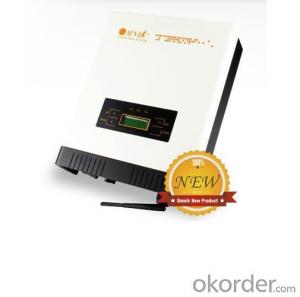Rec Solar Inverter On Grid Omniksol-3.0k-TL
- Loading Port:
- Shanghai
- Payment Terms:
- TT OR LC
- Min Order Qty:
- -
- Supply Capability:
- 3000 pc/month
OKorder Service Pledge
OKorder Financial Service
You Might Also Like
Omnik new energy solar inverter
Omniksol-2.0k-TL Photon Efficiency up to 3kW
in the world------ Photon tested Jan. 2012.
Omniksol-3k-TL
Futures
Transformerless design, high efficiency (Max.97.6%,Euro. 97.0%)
Multi MPPT channels
High MPP tracking accuracy(>99.9%)
Wide DC input range(120-590 Vdc), compatible with different
module technologies
Easy wiring, installating and operating
IP 65 design, suitable for indoor and outdoor installation
5 years warranty(10~25 years as option)
technical data:
Type | Omniksol-3.0k-TL | Omniksol-4.0k-TL | Omniksol-5.0k-TL |
Max. PV-Generator Power [W] | 3400 | 4500 | 5000 |
Max. DC voltage [V] | 590 | 590 | 590 |
MPPT DC voltage Range [V] | 150-500 | 150-500 | 150-500 |
Turn off DC voltage [V] | 120 | 120 | 120 |
Max. DC Current [A] | 36 | 36 | 36 |
Nominal DC Current [A] | 28 | 33 | 33 |
Number of DC Connection | 2 | 2 | 2 |
DC-Connection | MC4 | MC4 | MC4 |
Number of MPP trackers Turn on Power [W] | 2 | 2 | 2 |
Turn on power(W) | 10 | 10 | 10 |
- Q: Can a solar inverter be used with a remote monitoring system?
- Yes, a solar inverter can be used with a remote monitoring system. In fact, many solar inverters are designed to be compatible with remote monitoring systems, allowing users to monitor their solar energy production, system performance, and troubleshoot any issues remotely. This enables better control and management of the solar power system, ensuring optimal efficiency and performance.
- Q: Can a solar inverter convert DC power to AC power during a power outage?
- No, a solar inverter cannot convert DC power to AC power during a power outage. During a power outage, the solar inverter relies on the grid to function, and without grid power, it cannot convert DC power from the solar panels into usable AC power.
- Q: What is the role of a display or user interface in a solar inverter?
- The role of a display or user interface in a solar inverter is to provide a means for users to monitor and interact with the inverter's functionalities and data. It allows users to view real-time information about the solar power generation, system status, and any potential issues or errors. Furthermore, the user interface enables users to adjust settings, configure preferences, and troubleshoot problems if needed. Overall, the display or user interface enhances the usability and control of the solar inverter for users.
- Q: What is the difference between an on-grid and off-grid solar inverter?
- An on-grid solar inverter is designed to convert the DC power generated by solar panels into AC power that can be fed into the electricity grid. It synchronizes the solar power output with the grid's frequency and voltage, ensuring a seamless integration and allowing any excess power to be exported back to the grid. On the other hand, an off-grid solar inverter is used in standalone solar power systems that are not connected to the grid. It converts the DC power from solar panels into AC power for immediate use or storage in batteries. These systems typically require additional components like batteries and charge controllers to manage power storage and supply during periods of low solar generation or high demand. In summary, the main difference between the two types of inverters is their purpose: on-grid inverters are used for grid-tied systems, while off-grid inverters are used in standalone systems not connected to the grid.
- Q: How does a solar inverter handle voltage fluctuation during cloud cover?
- A solar inverter handles voltage fluctuation during cloud cover by continuously monitoring the output voltage of the solar panels. When cloud cover causes a decrease in sunlight and therefore a drop in voltage, the inverter adjusts its operation to maintain a stable output voltage. It does this by employing various techniques such as maximum power point tracking (MPPT) to optimize power generation, and voltage regulation to ensure the output voltage remains within the desired range. This helps to minimize the impact of voltage fluctuations and ensure the solar system continues to operate efficiently even during cloud cover.
- Q: Can a solar inverter be connected to a backup battery system?
- Yes, a solar inverter can be connected to a backup battery system. This allows the solar energy generated during the day to be stored in the backup battery system and used during times when the sun is not shining or during power outages.
- Q: How is a solar inverter connected to the solar panels?
- A solar inverter is connected to the solar panels through a direct electrical connection. The DC (direct current) electricity generated by the solar panels is fed into the inverter, which then converts it into AC (alternating current) electricity suitable for use in homes and businesses.
- Q: How do you maintain a solar inverter?
- To maintain a solar inverter, regular inspections and cleaning are essential. It is crucial to check for any signs of damage or loose connections, and make sure the inverter is properly ventilated to prevent overheating. Additionally, keeping the surrounding area clean and free from any debris or obstructions can help optimize its performance. It is recommended to follow the manufacturer's guidelines and consult with a professional for any specific maintenance requirements.
- Q: How do you calculate the maximum power point voltage for a solar inverter?
- To calculate the maximum power point voltage for a solar inverter, you need to determine the voltage at which the solar panels produce the maximum power output. This can be done by following the voltage-current (V-I) curve of the solar panels. By measuring the voltage and current at different points on the curve, you can identify the point where the product of voltage and current is the highest, indicating the maximum power point voltage.
- Q: Are there any safety considerations when installing a solar inverter?
- Yes, there are several safety considerations when installing a solar inverter. First, it is important to ensure that the installation is carried out by a qualified professional who is trained in handling electrical systems. This helps minimize the risk of electric shock or fire hazards. Additionally, proper grounding and insulation must be implemented to prevent electrical faults. It is also crucial to follow the manufacturer's guidelines and local electrical codes to ensure the safe and efficient operation of the inverter.
Send your message to us
Rec Solar Inverter On Grid Omniksol-3.0k-TL
- Loading Port:
- Shanghai
- Payment Terms:
- TT OR LC
- Min Order Qty:
- -
- Supply Capability:
- 3000 pc/month
OKorder Service Pledge
OKorder Financial Service
Similar products
Hot products
Hot Searches
Related keywords

